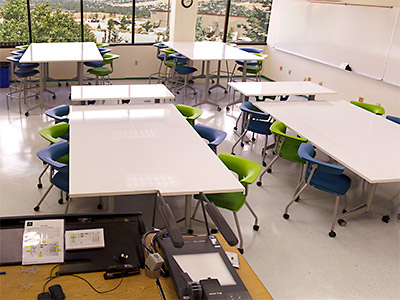
Sierra Building, room 212 at Truckee Meadows Community College is one of the new classrooms featuring a collaborative learning environment design.
High tables and group tables, discussion-friendly lounge furniture and maximized dry-erase walls are modernized and functional features of three newly redesigned classrooms at Truckee Meadows Community College.
Even the tables will allow students to write on them with dry-erase markers, for brainstorming and drawing out their ideas.
Vista Building, room 105, and Sierra Building, room 212 are two of the classrooms receiving a facelift with remodeling, new paint and furniture. Three total rooms will be redesigned for Fall Semester, one math and two English rooms.
They are taking shape, displaying the concept of a collaborative learning environment.
“In redesigning classrooms, a team of professional educators and facilities experts have taken on the roles of ‘social architects,’ creating an environment that encourages active and engaged learning,” said Jill Channing, PhD, Dean of Liberal Arts.
The environments consist of diverse spaces, levels for interaction, and some technological components. Furniture is on caster wheels for easy movement or reconfiguration. In Sierra 212, students as individuals or in groups will be able to project ideas from tablets to an Apple TV unit that projects an image to the instructor’s screen.
“In the case of one of our rooms, we’re even experimenting with the use of iPads and various apps,” she said. “The goal is for students to be involved and engaged, conducting research, collaborating, and sharing learning that happens in class. In this way, students are not passive learners but creators of knowledge.”
The professionals in the team leading the redesign along with Dr. Channing are English Instructors Josh Shinn and Karen Wikander, English Professor Cheryl Cardoza, Professional Development Manager Cathy Brewster, and Information Technology's Chris Quantrell.
“The first semester we see much experimentation happening,” Channing added. “Instructors teaching in these environments plan to meet on a regular basis to discuss teaching ideas and what is and what is not working well.”
Effectiveness of the Learning Spaces Also Analyzed
To study the effectiveness of the newly transformed learning environments, instructors and professors will teach different sections of the same course in both the new rooms and in traditional, existing classrooms.
Both teachers and students will be asked what they think about the redesign after working in the revamped spaces.
“They will be surveyed about how well they like the interactive furnishing concept, and how well the space performed for instruction,” said Teresa Golden, Manager of Facilities Operations and Capital Planning.
The Innovative Classroom
The team applied for and received an Innovation Grant of $5,000 to cover the cost of remodeling the rooms. Innovation Grants are dispersed by the TMCC Foundation, funded by faculty and staff donations and Dandini Campus Lot A parking meters.
The proposal, “Rethinking the Learning Space: The Innovative Classroom” addresses the desire by the team for a learning environment that may lead to more interactive discussions and hands-on learning. The classrooms will function as a pilot project, testing the viability of a more dynamic space, comparing it to the more traditional structures.
“Changing the classroom to a more adaptable space, one that builds in teacher and student engagement on a higher level through modular and movable furniture, inclusive technologies, and increased writing spaces, will address the issues with traditional classroom spacing, the rigidity of teaching and student interaction, and the confines of student expression due to the implications about authority suggested by traditional classroom space design,” according to the proposal.
Students write with dry-erase markers on the wall and tables, spaces typically forbidden. This may free students from preconceptions about the writing process, taking more ownership of their writing—giving them authority as creators.
A study of classroom design was presented at the League for Innovation in the Community College Conference in March. Humber College Professor Christine McCaw reported the results of her comparison study of classrooms for instruction of Retail Management course sections. Three different sections were examined in both traditional and collaborative spaces.
Detailed surveys of faculty and students revealed the following:
- In the collaborative room, students were on time for class 80 percent of the time, and 57 percent in the traditional room
- Students in the collaborative setup were on task an average of 71 percent of the time, with a 63 percent engagement rate in the traditional setup
- Engagement by visual aids in the collaborative room was at 90 percent, while the traditional classroom rated about 50 percent
Also, the collaborative space had a positive effect on the quality of interactions between students, with students and their instructor, and in the use of critical thinking skills.
More information
“We also hope to use what we learn to expand classroom redesign efforts and to create training for instructors using such spaces,” Channing said.
For more information on the remodeled learning spaces, please contact Dr. Jill Channing, or English Department Co-Chair Cheryl Cardoza.






